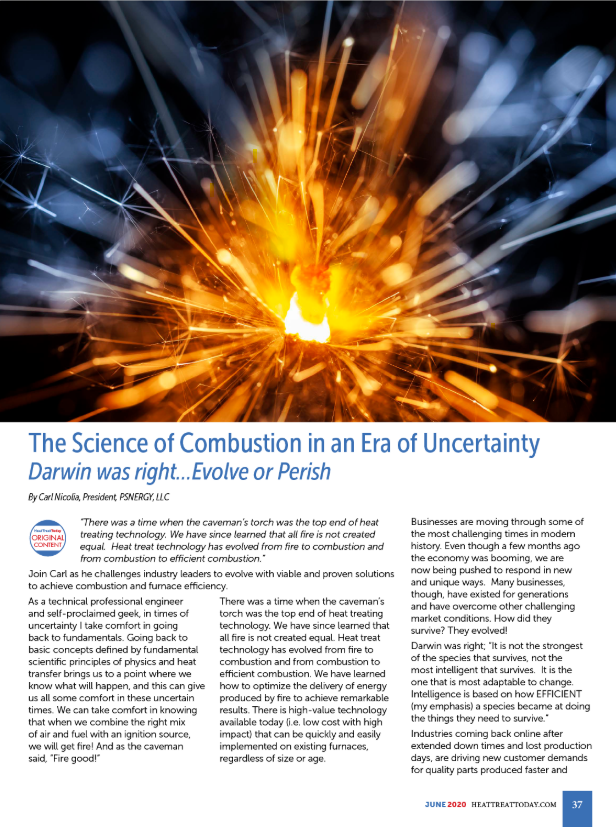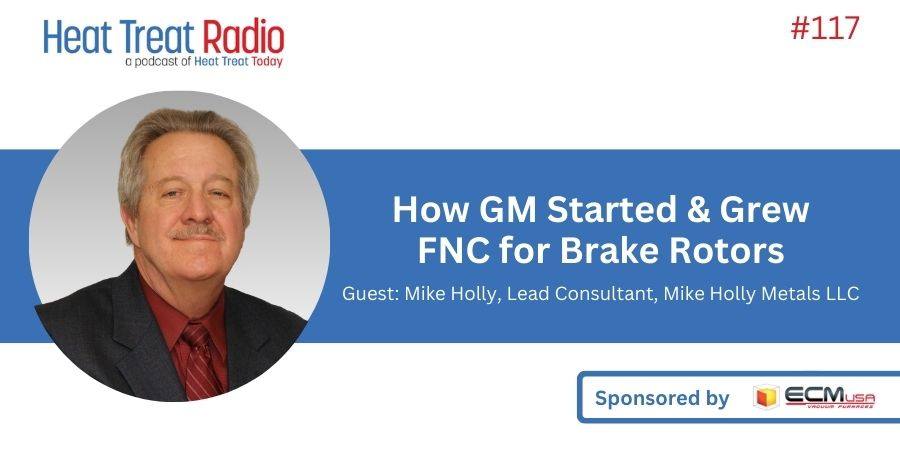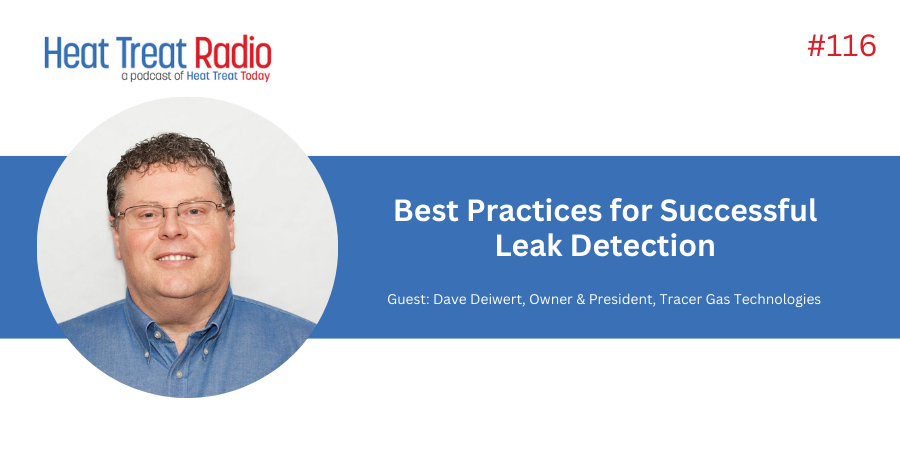 Welcome to another episode of Heat Treat Radio, a periodic podcast where Heat Treat Radio host, Doug Glenn, discusses cutting-edge topics with industry-leading personalities. Below, you can either listen to the podcast by clicking on the audio play button, or you can read an edited version of the transcript. To see a complete list of other Heat Treat Radio episodes, click here.
Welcome to another episode of Heat Treat Radio, a periodic podcast where Heat Treat Radio host, Doug Glenn, discusses cutting-edge topics with industry-leading personalities. Below, you can either listen to the podcast by clicking on the audio play button, or you can read an edited version of the transcript. To see a complete list of other Heat Treat Radio episodes, click here.
In this conversation, Heat Treat Radio host, Doug Glenn, interviews Carl Nicolia, President of PSNergy, to learn about how applying efficient combustion can drastically improve the performance of your machines. Click below to hear about high value solutions and where we stand in the "evolution" of combustive techniques.
Click the play button below to listen.
The following transcript has been edited for your reading enjoyment.
Doug Glenn (DG): Today's topic is combustion. It is not only an important feature, but also the core to heat treat as the key to high value solutions; that is, according to today's guest, Carl Nicolia (CN), the president of PSNergy. Carl wrote an article that appeared in a recent edition of Heat Treat Today entitled, The Science of Combustion in an Era of Uncertainty. Several of the points Carl dealt with in that article, we'll deal with today. Get ready to read why not all fire is created equal and why your company needs to evolve with the times and take advantage of the recent combustion efficiency technologies.

DG: Carl, tell us about your background.
CN: I had a great career in larger global businesses - folks like GE and Chrysler Corporation. After that run, I had met several very smart people that had been in the combustion industry for some time and they had some unique ideas on how we could really truly help elevate the performance of heat treating operations. After doing some homework on the industry, the technology, and the opportunity there, we started PSNergy in May of 2013. Since then, we have been helping customers, really throughout North America, solve combustion issues and help deliver productivity to combustion operations. We are primarily focused on radiant tube combustion systems. We do some open fire work as well. The team itself brings over 40 years of combustion experience to the table. We were really formed on innovation around the fundamental sciences, mostly physics and heat treat, and with a huge obsession for customer satisfaction. We really like to take the approach of becoming part of the customer's team, not really being considered an outside resource, but more of a team member with them, and really develop and play for the long term. That's the background on how we got into the combustion industry.
DG: The immediate reason for us talking with you today is because in our June 2020 issue, on page 37, we had a very interesting article or column written by yourself entitled The Science of Combustion in an Era of Uncertainty: Darwin was right, Evolve or Perish. That was the name of the column. A little bit provocative and an interesting column. And, for those who might be reading this at a later point, we are on the, I want to say, the tail end of a Covid-19 pandemic, but some people might say we're in the middle of it. Nonetheless, that's why the article says, “in an era of uncertainty.” I want to talk to you a little about that column. You make this comment in there, and there are a couple of comments I want to ask you about, and then we'll move on to the more substantive stuff. You say, “All fire is not created equal.” This is an interesting comment. What did you mean by that?
CN: Our team has been having a lot of fun with the caveman references and the whole concept of evolution and when we thought about it, it really did apply well, especially in today's times. We won't get into whether we're at the beginning, middle or end of the Covid thing, but thinking about going from fire at the end of a club to modern combustion systems is a huge leap forward. It was a good way for us to think about and highlight the concept that all fire is not created equal. Just because the burners are firing and the furnace is hot, doesn't mean that you're burning efficiently. There is a big difference between well-tuned, well-balanced combustion systems, and not well-tuned and well-balanced. So in that reference, we talk about setting combustion appropriately: getting the right air/fuel ratio can mean the difference between, in a heat treater's case, profitability and loss or high quality and scrap. Balancing that combustion across the entire system can mean the difference in getting customers and providing the turnaround times that they need. Getting that combustion system balanced and tuned, and keeping that system balanced and tuned, are really essential to “getting the most out of your fire,” if you will. So we had some fun with that reference. You will see that carry through some our advertising in the months to come, as well.
DG: You make one other reference to Charles Darwin and a quote that he mentioned. The quote is not all that brief, but I wanted you to comment on it, if you could. It says “It is not the strongest of the species that survive, nor the most intelligent that survive. It's the one that is most adaptable to change. Intelligence is based on how efficient a species became at doing the things they need to survive.”
CN: That's a great quote, and again, we're having a little bit of fun with it, but especially in today's world. I know that many of your readers have been in operation for generations and those companies have found a way to get a little better, a little smarter, every day, every year, and have not gone through Covid-19, but I'm sure other different issues. I think having them focus on what's critical, really making smart investments, these are the type of things that help move their operations forward, help evolve their operation. That's the type of evolution we're talking about.
Evolution to us is small, impactful changes that make a big difference. Although today it might be difficult to imagine, end customers in automotive, construction, and off-highway vehicles are going to be back. And there is going to be pent-up demand. Productivity is going to be an issue in the months ahead. Our end customers, as they come back online and look for suppliers that can meet that rate with high quality and responsiveness, that's going to be a differentiator. And so, we think that thinking about that evolution now is really important. Making the changes now while you can and be responsive when the time comes, is the right move for us; that's the evolutionary piece.
DG: PSNergy, as you've already mentioned, really focuses in on combustion, combustion efficiency, furnace efficiency and that type of thing. On the second page of this article (page 38 in the June 2020 issue), you mention a case study in there where your crew went in and helped a contract commercial heat treater to improve some efficiency. Can you run down through that case study quickly and tell us what you guys were able to do to help them adapt and improve the type of fire they had in their organization?
CN: Sure. And this is a great story, but it is not a unique story for us. We have quite a few of these success stories around our products and services. We had a Midwest contract heat treating company that was interested in the ceramic waste heat recovery inserts. These are patented devices that we design here at PSNergy. They go into the exhaust leg of the radiant tube and they capture that energy that is normally lost out the exhaust, keeping that energy inside the furnace. In the process, it balances the tube temperature and really increases the productivity of the process.
[blocktext align="left"]Their recovery cycle was reduced by 25% ... And in that total cycle, they dropped gas consumption 5% which eventually led to an increase in output of that furnace by 10% ... the total cost to implement this was less than $10,000.[/blocktext]So, in this particular example, it was a 9-ft IQ furnace and it had four U-tubes, probably a pretty typical type of furnace that we might see in a lot of the contract heat treating manufacturers, like your audience. What we did was install inserts in the exhaust legs of the four tubes and then balanced and tuned the system. This entire process took less than one 8-hour shift to finish. As you can see, the results were really impressive. I always like to say at this point, this is not our data, this is customer data. Their recovery cycle was reduced by 25%. Now, a recovery cycle is from the time I close the door to the time I start my controlled cycle. 25% reduction. And in that total cycle, they dropped gas consumption 5% which eventually led to an increase in output of that furnace by 10%. What we love about this, and this is kind of the theme of the article really, is that the total cost to implement this was less than $10,000. This is a perfect example of high value solution. I hate to say 'low cost' because cost is relative, but this is high value. If I can deliver 25% improvement with less than $10,000, or if I can deliver 10% double-digit output increases for less than $10,000, that's a high value solution.
DG: At $2500/tube, and you had four tubes you were 'upgrading,' if you will, that's pretty impressive.
CN: The beauty of this was there were no piping changes, no construction, and no long downtime. By using the patented technology, the new technology that's out there, combined with our tech-enabled services (balancing and tuning), again using the latest in sensing technology and cloud computing, this customer was able to achieve significant performance improvement. What's awesome is that this is a pretty common story for us. When we do this, these are the types of numbers we can achieve.
DG: We kind of skimmed over a little bit about the inserts. Let’s take just a minute and make clear what exactly you're providing as far as the inserts primarily, and the services as well.
CN: The radiant tube inserts, we like to call them ceramic waste heat recovery devices or waste heat recovery inserts, are primarily silicon carbide and they are in a patented configuration that provides significant improvement in delivering energy through the tube into the load. And they do that by being the right material, (silicon carbide has a very high emissivity, having the right shape, where we take advantage of radiant energy transfer to the tube because of the shape of the insert, and having a wide open cross-section which does not put a lot of back pressure on the combustion system; we allow the combustion system to breathe. Inserts have been around for a long time. The big technology improvement here is having the right material and having it in the right configuration to maximize the amount of energy that is delivered in a radiant tube and minimize the effect on the combustion system.
DG: And are these inserts only for U-tubes?
CN: No, they can be applied on any radiant tube. We've applied them on straight tubes (or I-tubes), U-tubes, Trident® tubes, and W-tubes.
DG: You talk in the article about combustion efficiency and furnace efficiency. Can you elaborate on that and the difference between the two?
CN: We think about this relatively broadly. Combustion efficiency is getting the most energy out of the fuel you purchase, and ensure that you continue to get that same level of performance. This is happening at the combustion system level, the burners, if you will. This goes back to achieving optimal air/fuel ratios. And it is so important, yet often overlooked by a lot of people. The difference between 7% excess oxygen in the exhaust and 3% excess oxygen is significant. If you're at 7% excess oxygen, you're delivering 20% less energy to the furnace than you are at 3%. 20% is a huge, huge number. Especially when you're talking about the core process for heat treating operations, making heat. I think often times we forget that in heat treating, combustion is the core process. Anytime we're running through a heat treat operation, you have to have optimal combustion. And there are high value, easily implemented solutions out there that help you maintain and achieve the optimum combustion.
When we think about furnace efficiency, furnace efficiency is what our customers get paid for - getting energy from the combustion system to the product. And how well we do that, in our view, is furnace efficiency. Think about it this way: You could have a perfectly balanced and tuned combustion system (those four tubes on our example furnace can be tuned perfectly), but we can let, in that system, 40% of the energy escape out of the exhaust. So combustion efficiency might be high, but furnace efficiency is not optimal. That's where we think about implementing the ceramic waste heat recovery devices, for example. You could talk about textured tubes or bubble tubes as another example to help you get that energy from the combustion system into the load. Getting more of the energy produced in efficient combustion for that product being processed – that's the name of the game, and that's furnace efficiency as we see it.
DG: You and I were talking about a recent report that came out from ArcelorMittal regarding their “green movement.” Can you recap that, and maybe hit on the ability for small companies to also embrace the technology that some of these bigger companies are able to embrace?
CN: We found this very informative. ArcelorMittal issued their 2019 “integrated report,” where they discuss their corporate responsibility and sustainability initiatives in the US. They have ten sustainability development outcomes, and energy management is one of those ten key outcomes. ArcelorMittal highlighted the development of a low-cost oxygen sensor for furnaces that reduce fuel consumption by allowing plants to see that combustion performance and then tune for optimization. This goes back to our discussion: Furnace combustion performance is the core to these operations, and they're highlighting the value of getting combustion balanced and tuned correctly and keeping it correct.
Not everyone listening and reading, I'm sure, has the resources of ArcelorMittal, so luckily, PSNergy has developed this technology for everyday heat treating operations and any one of us can now apply this. In fact, the same leading edge sensing technology and cloud computing technology is what our service team uses to deliver our combustion engineering services, or balance and tuning, and that is also incorporated into our combustion monitoring and alerting system. We like to call that CMA. And installing CMA on your furnace is like having a dedicated technician taking combustion measurements every day. If something is starting to go out of tune, actions can be taken immediately before furnace performance is affected and alerts can be sent through the system. Daily reports are issued on combustion and so you know combustion is running well. And if it's not, you're deploying resources to get that out.
DG: So this combustion monitoring and alerting system is a cloud-based system?
CN: Yes, it is, but fundamentally, it is a sensor. It's oxygen monitoring and pressure monitoring that is installed on each individual tube of the furnace that records excess oxygen in the stack just as if you would stand there as a technician with a handheld meter, but this is all connected through the cloud which allows it to be accessible, which allows it to store the data for future trend analysis. We've been able to use that tool to identify failing motorized control valves, declining performance on combustion air fans, etc. There is so much that you can see over and above when you're starting to look at data over time versus a single point in time and that's where the cloud piece comes in. It starts with pulling the sample from the right spot in situ from the exhaust and having the highest level of sensing technology available on the oxygen side and then sending all of that up to the cloud for the analysis for the reporting. It basically is a tech standing there taking measurements every day and then you're able to then get a report that says this is where our combustion is, and I can take steps to do that.
DG: I've got a question about that. So you've got 24/7, 365 monitoring of the system, cloud-based, the reports are coming back to the people in the company only – and only to those people that need to know. Are these things that you guys are alerted to so that you call if something goes wrong, or is it basically just held in-house?
CN: It can be either. You have the option of adding our team into it and we can provide input. The one thing we have decided though is any time the system is deployed, we never want to see that system not functioning properly. We keep a close eye on it. The combustion measurements are only a small piece. There are also a lot of help measurements around the system itself, so we're able to keep an eye on the system. If something started to go wrong from a system standpoint, we haven't seen that yet, but if it ever does, we're able to send our technicians out to make sure that you don't get a break in that monitoring.
DG: Have you had any issues with companies being concerned about cybersecurity?
[blocktext align="right"]Get it right and keep it right and then get the most out of the gas that you purchase. Stop throwing away energy. [/blocktext]CN: Not yet. We deal with that in two ways. Number one is that the data we're taking is relatively agnostic. I'm going to see basically pressures and excess oxygen readings and it's not really associated with anything else. Typically, when we get an output through the customer's system, that is usually on the other side of their firewall so the system security is in place and we can have a clean channel out to our cloud. When customers are uncomfortable with that, we'll use cell technology to deliver that, so there is no interconnectivity to their system. We have thought that through. Some customers are more uncomfortable than others, but we've done it both ways, where we've connected through a portal in their system to get out to the internet and then we've also connected through cellular.
DG: Is it possible to have a completely contained system where there is no internet connectivity?
CN: No. Because a lot of the calculations and analysis is done in the cloud. It's not to say that we haven't been asked for that, and we are working on local displays for let's say a technician that just wants to walk up to the furnace and see how things are running; we do have provisions for that as well.
DG: “All fire is not created equal” we know that, so it sounds like PSEnergy has got some good options for people to help improve and maintain not only combustion efficiency but also furnace efficiency. The example you had in the article was for a commercial heat treater, but obviously this also applies to anybody who's doing any type of combustion heating, captive heat treaters, manufacturers or commercial.
What exactly would you emphasize to these manufacturers with their own in-house heat treating, or in the commercials, about the importance of combustion in the heat treating process?
CN: Combustion is really the core of their process. If I could leave you with a message that there are high value easily implemented solutions for achieving and maintaining that optimal combustion, then I think we've given the listeners and readers a little bit of value here. Get your combustion right and keep it right, and then look for that technology that is available out there that can help you get the most out of every BTU that you burn.
DG: Exactly. And the payback is almost a no-brainer in a lot of situations. Obviously, each situation is going to be unique, but the example you gave in the article, the payback was enormously good. It's certainly worth investigating.
CN: It is. It's always worth investigating when it's about achieving more output. When you can achieve more output and ring the cash register more and create more opportunities for selling additional product or new product capacity, those are easier ROIs. If we're just looking at wanting to save fuel, well sure, that pencils out in that case, it's just not the same sort of three-month turnaround or as quick.
In our case, we recommend three areas: Get combustion right and keep it right, with a tech-enabled service team and monitoring. I really wanted to point out, and we've heard this a hundred times– if it's not measured, it's not sustained. The core of heat treating is combustion, yet very few of us actually measure the performance of combustion. We might measure the output (temperature), but we don't measure excess oxygen, which is really the necessary metric to achieve the efficiency. The big steel example there kind of guides us. You should never wonder how well your combustion system is running. You should know with data. That's the core of your process.
So, get it right and keep it right and then get the most out of the gas that you purchase. Stop throwing away energy. Utilize these high value, easily implemented solutions and get the most out of it.
And the piece that we really didn't talk about was- train your team. There are combustion trainings out there. Ours is specifically geared towards combustion and really for heat treating operations, but train your team and talk about a common understanding and a common language around combustion. That dispels a lot of myths around combustion and exposes the team to the latest technologies and best practices.
Lastly, keep reading and listening to Heat Treat Today and Heat Treat Radio because that's the best way to stay informed on the latest technologies. You've got to keep up on it. All kidding aside, it is a really great way, the information that you guys provide is significant towards staying up on the technology.
DG: I appreciate that shameless promotion there. ~chuckles~
If someone wanted to get a little more information, what are you comfortable giving out as far as contact information for people to get a hold of you?
CN: My email is cnicolia@psnergy.com and my phone number is 814-504-2326.
DG: So Carl, thanks very much for joining us today.
CN: Doug thank you, I appreciate the opportunity to speak about the technologies.
Read the original article, The Science of Combustion in and Era of Uncertainty, here.

To find other Heat Treat Radio episodes, go to www.heattreattoday.com/radio and look in the list of Heat Treat Radio episodes listed.







